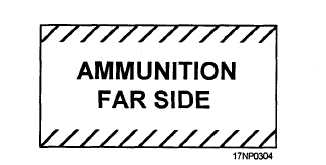magazine locations of a typical CV (aircraft carrier).
For safety reasons, various types of explosives and
ammunition are stowed in separate magazines or
lockers.
The type of stowage varies with the type of ship, the
space available, and the amounts of explosive involved.
All magazines are marked by label plates that designate
the compartment and the types of ammunition stowed
in them. Magazines are marked with warnings that
apply to specific special hazardous conditions and
operations. Additionally, paint-stenciled labels or
painted signs are installed on the outside surfaces of
ammunition stowage spaces (except where the outside
surfaces are visible from the exterior of the ship). The
stenciled markings must be located on the bulkheads,
overheads, and decks 12 feet apart. The sign or label
(fig. 11-4) is a yellow rectangle, 5 inches high by 9
inches wide. The sign has black slanted lines, 1/8-inch
thick and 1 inch long, on 3/4-inch centers along the top
and bottom edges, with lines slanting from top right to
bottom left. The letters are 1/8-inch thick and 3/4-inch
high, with the words AMMUNITION FAR SIDE
arranged as shown in figure 11-4. Primary and missile
magazines aboard CVs are designed to hold a ship’s
service allowance and the embarked air wing’s service
allowance of ammunition.
Ships have several different types of magazines.
Each magazine is designed for a specific type of
ammunition.
The magazine types include primary,
missile, ready-service, lockers, and chemical.
Primary Magazines
Primary magazines are stowage spaces that are
usually located below deck and, if possible, below the
waterline. They are adequately equipped with thermal
insulation, temperature control, and ventilation.
Primary magazines are equipped with adequate
sprinkler systems, and they are closed and locked when
unattended.
Figure 11-4.—Example of AMMUNITION FAR SIDE sign or
label.
Missile Magazines
Because of the nature of guided missiles,
requirements for their stowage aboard ship differ from
those of conventional ammunition. Air-launched
missile magazines in aircraft carriers are usually located
below the waterline and within the armor box.
Air-launched missile ready-service magazines may be
located either above the waterline or within the armor
box. Missile magazines contain electrical, hydraulic,
and pneumatic power-operated handling equipment. A
restraining gear prevents movement of an accidentally
ignited motor. Magazines are equipped with specialized
detection equipment to make sure that a specific missile
hazard isn’t present. You must take special care of the
ventilation system of missile magazines to ensure
pressures don’t build up to a dangerous level if a missile
motor is ignited.
Additional fire-fighting equipment is often
provided for missile magazines. This equipment may
consist of carbon dioxide, foam, water injection, or a
sprinkler system, or a combination of these systems.
NAVSEASYSCOM specifically certifies the magazine
for the stowage of hyperbolic-fueled missiles, such as
the AQM-37 target drone and fuel-air explosive (FAE)
weapons. FAE weapons and the AQM-37 are
compatible in stowage.
FAE weapons require less
stringent certified facilities; therefore, FAE weapons
can be stowed in hyperbolic magazines. However,
hyperbolic-fueled items cannot be stowed in magazines
certified for FAE only.
Ready-Service Magazines
Ready-service magazines (fig. 11-5) are designated
spaces located near the weapon or area to be served.
Normally, they are equipped with thermal insulation,
ventilation, and a sprinkling system. They are securely
locked. Certain magazines located within the armor box
of aircraft carriers and used for stowage of completely
assembled rounds of weapons and deployable targets
are also ready-service magazines.
Lockers
Certain compartments or lockers are used to
stow special types of ammunition and ammunition
components, such as detonators, pyrotechnics, and
chemicals. They are frequently located on the weather
deck. They are located as conveniently to the weapon
or space to be served as possible. They may not be
equipped with sprinklers, but they do have locking
devices. Special flare ready-service lockers are located
11-8

